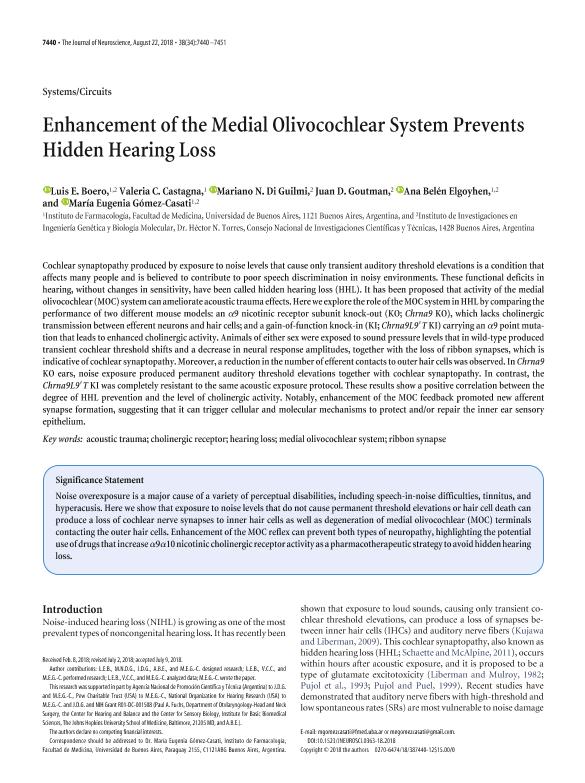Mostrar el registro sencillo del ítem
dc.contributor.author
Boero, Luis Ezequiel

dc.contributor.author
Castagna, Valeria Carolina

dc.contributor.author
Di Guilmi, Mariano Nicolás

dc.contributor.author
Goutman, Juan Diego

dc.contributor.author
Elgoyhen, Ana Belen

dc.contributor.author
Gomez Casati, Maria Eugenia

dc.date.available
2020-01-02T15:58:36Z
dc.date.issued
2018-08
dc.identifier.citation
Boero, Luis Ezequiel; Castagna, Valeria Carolina; Di Guilmi, Mariano Nicolás; Goutman, Juan Diego; Elgoyhen, Ana Belen; et al.; Enhancement of the medial olivocochlear system prevents hidden hearing loss; Society for Neuroscience; Journal of Neuroscience; 38; 34; 8-2018; 7440-7451
dc.identifier.issn
0270-6474
dc.identifier.uri
http://hdl.handle.net/11336/93284
dc.description.abstract
Cochlear synaptopathy produced by exposure to noise levels that cause only transient auditory threshold elevations is a condition that affects many people and is believed to contribute to poor speech discrimination in noisy environments. These functional deficits in hearing, without changes in sensitivity, have been called hidden hearing loss (HHL). It has been proposed that activity of the medial olivocochlear (MOC) system can ameliorate acoustic trauma effects. Here we explore the role of the MOC system in HHL by comparing the performance of two different mouse models: an α9 nicotinic receptor subunit knock-out (KO; Chrna9 KO), which lacks cholinergic transmission between efferent neurons and hair cells; and a gain-of-function knock-in (KI; Chrna9L9′T KI) carrying an α9 point mutation that leads to enhanced cholinergic activity. Animals of either sex were exposed to sound pressure levels that in wild-type produced transient cochlear threshold shifts and a decrease in neural response amplitudes, together with the loss of ribbon synapses, which is indicative of cochlear synaptopathy. Moreover, a reduction in the number of efferent contacts to outer hair cells was observed. In Chrna9 KO ears, noise exposure produced permanent auditory threshold elevations together with cochlear synaptopathy. In contrast, the Chrna9L9′T KI was completely resistant to the same acoustic exposure protocol. These results show a positive correlation between the degree of HHL prevention and the level of cholinergic activity. Notably, enhancement of the MOC feedback promoted new afferent synapse formation, suggesting that it can trigger cellular and molecular mechanisms to protect and/or repair the inner ear sensory epithelium.
dc.format
application/pdf
dc.language.iso
eng
dc.publisher
Society for Neuroscience

dc.rights
info:eu-repo/semantics/openAccess
dc.rights.uri
https://creativecommons.org/licenses/by-nc-sa/2.5/ar/
dc.subject
ACOUSTIC TRAUMA
dc.subject
CHOLINERGIC RECEPTOR
dc.subject
HEARING LOSS
dc.subject
MEDIAL OLIVOCOCHLEAR SYSTEM
dc.subject
RIBBON SYNAPSE
dc.subject.classification
Otras Ciencias Biológicas

dc.subject.classification
Ciencias Biológicas

dc.subject.classification
CIENCIAS NATURALES Y EXACTAS

dc.subject.classification
Otras Ciencias Biológicas

dc.subject.classification
Ciencias Biológicas

dc.subject.classification
CIENCIAS NATURALES Y EXACTAS

dc.title
Enhancement of the medial olivocochlear system prevents hidden hearing loss
dc.type
info:eu-repo/semantics/article
dc.type
info:ar-repo/semantics/artículo
dc.type
info:eu-repo/semantics/publishedVersion
dc.date.updated
2019-10-16T16:00:37Z
dc.journal.volume
38
dc.journal.number
34
dc.journal.pagination
7440-7451
dc.journal.pais
Estados Unidos

dc.description.fil
Fil: Boero, Luis Ezequiel. Consejo Nacional de Investigaciones Científicas y Técnicas. Instituto de Investigaciones en Ingeniería Genética y Biología Molecular "Dr. Héctor N. Torres"; Argentina. Universidad de Buenos Aires. Facultad de Medicina; Argentina
dc.description.fil
Fil: Castagna, Valeria Carolina. Universidad de Buenos Aires. Facultad de Medicina; Argentina. Consejo Nacional de Investigaciones Científicas y Técnicas; Argentina
dc.description.fil
Fil: Di Guilmi, Mariano Nicolás. Consejo Nacional de Investigaciones Científicas y Técnicas. Instituto de Investigaciones en Ingeniería Genética y Biología Molecular "Dr. Héctor N. Torres"; Argentina
dc.description.fil
Fil: Goutman, Juan Diego. Consejo Nacional de Investigaciones Científicas y Técnicas. Instituto de Investigaciones en Ingeniería Genética y Biología Molecular "Dr. Héctor N. Torres"; Argentina
dc.description.fil
Fil: Elgoyhen, Ana Belen. Universidad de Buenos Aires. Facultad de Medicina; Argentina. Consejo Nacional de Investigaciones Científicas y Técnicas. Instituto de Investigaciones en Ingeniería Genética y Biología Molecular "Dr. Héctor N. Torres"; Argentina
dc.description.fil
Fil: Gomez Casati, Maria Eugenia. Consejo Nacional de Investigaciones Científicas y Técnicas. Instituto de Investigaciones en Ingeniería Genética y Biología Molecular "Dr. Héctor N. Torres"; Argentina. Universidad de Buenos Aires. Facultad de Medicina; Argentina
dc.journal.title
Journal of Neuroscience

dc.relation.alternativeid
info:eu-repo/semantics/altIdentifier/url/http://www.jneurosci.org/content/38/34/7440.long
dc.relation.alternativeid
info:eu-repo/semantics/altIdentifier/doi/http://dx.doi.org/10.1523/JNEUROSCI.0363-18.2018
Archivos asociados
